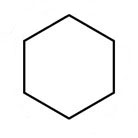What is Cyclohexanone?
Cyclohexanone (also known as oxocyclohexane, pimelic ketone, cyclohexyl ketone, and CYC) is a clear oily liquid that has a colourless to light yellow tinge and a pungent odour. It is a sixcarbon cyclic molecule belonging to the class of cyclic ketones (organic compounds) with the formula C6H10O.
It is slightly soluble in water, completely miscible with common solvents and reacts with oxidants such as nitric acid. It occurs naturally in crude oils and is also produced synthetically, in large quantities, as it is a key intermediate in the production of nylon.

Technical Properties
Chemical and physical properties of cyclohexanone:
Molecular Formula: C6H10O / (CH2)5CO
Synonyms: Ketohexamethylene, oxocyclohexane, sextone, pimelic ketone, pimelin ketone, cyclohexyl ketone, Hydrol-O, anone, CYC.
Cas Number: 108-94-1
Molecular Mass: 98.14 g/mol
Exact Mass: 98.073165 g/mol
Flashpoint: 111°F / 43.9
Boiling Point: 312.1 ° F / 155.6 at 760 mm Hg
Melting Point: 3 ° F/ -16.1 ° C
Vapour Pressure: 101.7° F at 10 mm Hg
Water Solubility: 50 to 100 mg/mL at 64° F
Density: 0.945 at 68 °F
How is cyclohexanone made?
There are several methods of manufacturing cyclohexanone, one of which being the catalytic hydrogenation of phenol:
C6H5OH + 2 H2 → (CH2)5CO
Another method is via the catalytic air-oxidation of cyclohexane, typically in the presence of cobalt crystals:
C6H12 + O2 → (CH2)5CO + H2O
This reaction is one of the primary commercial bulk manufacturing methods, the other being the hydrogenation of benzene (in a closed system).
Other methods include the catalytic dehydrogenation of cyclohexanol:
C6H11OH → C6H11OH + H2
Worldwide, thousands of tonnes of cyclohexyl ketone are produced annually. Demand for it is still growing, especially in China, and several new production plants have come on-line in the past few years in order to help meet this demand.
Handling, storage and distribution
Hazards and toxicity
Cyclohexanone has an NFPA health rating of 1 and “can cause significant irritation”. If inhaled, it can irritate the throat and respiratory passages, causing headaches and nausea. Excessive exposure to the eyes, nose and skin can cause similar effects such as irritation, drowsiness, and unconsciousness.
It has an NFPA fire rating of 3 and “can be ignited under almost all ambient temperature conditions”. Heat, sparks, or flames can and create vapours that are heavier than air and will travel to the source of the ignition and surrounding areas. An instability rating of 0 indicates that it is “normally stable, even under fire conditions”.
Safety and procedures
In the case of a spillage, the leak should be isolated at a minimum of 50 metres and avoid being walked through. You should also prohibit the leak from spreading into waterways, sewers, and basements. Soak up the spillage with dry materials such as dirt or combustible materials.
Cyclohexanone has a low flash point; therefore, fires can easily be ignited. In the case of a fire, all ignition sources should be removed, and alcohol-resistant foam, dry chemical or CO2 should be used to fight. PPE equipment should always be worn when handling cyclohexanone to protect the skin and eyes. Contaminated clothing should be removed immediately.
Storage and distribution
Cyclohexanone can be transported in drums and/or tank trucks. It should be stored in a cool, dry, well-ventilated area that is free from the risk of ignition. For transportation purposes, it falls into packing group III and hazard class III and it is an Irritant and is highly flammable. It has a specific gravity of 0.945 and a flashpoint of 46 °C (closed cup).
Cyclohexanone uses
Cyclohexanone uses in industry
Cyclohexanone has many industrial uses, primarily as an industrial chemical and chemical intermediate in the production of specific target molecules. In fact, the consumption of cyclohexanone is linked almost entirely to the nylon industry with derivatives oxidised to produce adipic acid and caprolactam, which are precursors for nylon 6. Up to 70% of the world’s caprolactam is produced via cyclohexanone.
Other cyclohexanone derivatives are used for the synthesis of pharmaceuticals, dyes, herbicides, pesticides, plasticisers, and rubber chemicals. Additional industry uses of cyclohexanone include as an adhesive, fuel, paint and coating additive and laboratory chemical.
Cyclohexanone is used as a solvent for lacquers, paints, resins, degreasers, spot removers, polymers, copolymers, waxes, crude rubber, cellulose acetate, the manufacturing of herbicides and anihistamines.
Consumer uses
Cyclohexanone is found in various consumer products including in adhesives, paints, automotive, cleaning and furnishing care products, electronics, and photo chemicals.



